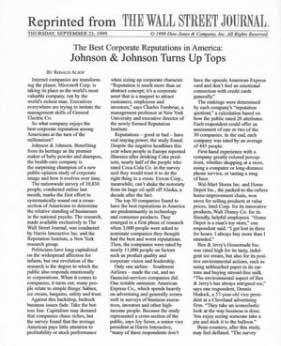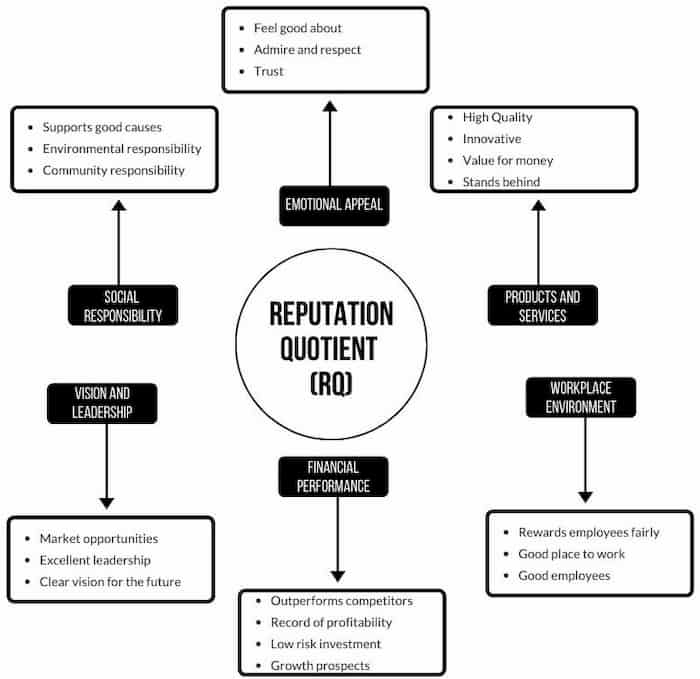All About the Reputation Quotient Model and How It Works
- We live in an economy where about 70-80% of market value is derived from intangible assets such as corporate reputation.
- A company’s reputation is easier to gauge than you might think thanks to the Harris-Fombrun Corporate Reputation Quotient Model (CRQ).
- Many people consider The Harris Poll/CRQ to be a reliable validation of corporate reputation, so it can drive public perception of a company positively or negatively.
- The CRQ has become an invaluable tool for companies when managing corporate reputation and identifying new market risks and opportunities.
Brand reputations are notoriously difficult to quantify. We can easily assign a numerical value to assets like cash, accounts receivable, and inventory. But there are plenty of intangible assets like copyright and your online reputation.
So how do we quantify the intangible? One way is to use the Corporate Reputation Quotient Model.
What is the Corporate Reputation Quotient Model?
Reputations are as important to protect as ever. This is true on an individual level but applies tenfold to corporations trying to get ahead in a competitive market. After all, we live in an economy where about 70-80% of market value is derived from intangible assets such as brand equity and public perception.
Corporate reputation is of growing relevance to organizations of all shapes and sizes. The amount of scholarly content on the web exploring corporate reputation is just one of many indications of the uptick in its importance.
Monitoring your corporate reputation, as well as comparing your reputation both within and across industries, is an integral part of running a business. The Corporate Reputation Quotient (CRQ) Model by Harris-Fombrun is one of the best sources for this information.
The Harris-Fombrun reputation quotient model is a standardized and comprehensive corporate reputation measurement that is different than the Net Promoter Score. Savvy business owners and their reputation managers use the model to better understand the perceptions of their corporate stakeholders, such as consumers, investors, employees, and key influencers.
The first annual reputation quotient results were published by The Wall Street Journal in September 1999. Health and pharmaceutical giant Johnson & Johnson made headlines by taking the top spot in the report that year.

Since then, the report has been published annually to rank the top 100 companies based on corporate reputation and become better known as The Harris Poll.
Besides a few minor adjustments, the model has remained the same for the last 20-plus years. The Harris-Fombrun CRQ Model is made up of six dimensions and 20 attributes that are graded by research participants on a 1-7 scale (1 = “Does not describe well” and 7 = “Describes very well”).
Harris-Fombrun Reputation Quotient Methodology
The Harris-Fombrun CRQ uses a 2-phase data collection process to gather the information that is run through the model and then published as a report. The methodology of that 2-phase process is as follows:
Phase 1: Nominations
Interviewees answer two open-ended questions:
- Of all the companies you know or are familiar with, which two would you say have the best reputations?
- Of all the companies you know or are familiar with, which two would you say have the worst reputations?
Responses are then tallied, subsidiaries are placed within parent companies, and a list of the “most visible” companies (nominations) is created.
Phase 2: Ratings
A separate sample of interviewees provides detailed ratings of up to two companies with which they are “very” or “somewhat” familiar. Ratings on the 20 attributes determine the company’s reputation quotient. Results are carefully weighted to ensure generalizability to the national population.
Why is the corporate reputation quotient important?
A company’s reputation can make or break a business.
“Good corporate reputations are critical because of their potential for value creation, but also because their intangible character makes replication by competing firms considerably more difficult.”
— Corporate reputation and sustained superior financial performance by P.W. Roberts & G.R. Dowling – Strategic Management Journal (2002)
There are many methods to gauge the public sentiment of your company and even ways to fix a damaged corporate reputation if needed. But the corporate reputation quotient should always be at the top of mind because it is widely accepted as the most comprehensive measure of stakeholder perception.
Many people consider The Harris Poll/CRQ to be a reliable validation of corporate reputation, so it can drive public perception that either positively or negatively affects a business’s bottom line.
As a result, the reputation quotient model has become an invaluable tool for companies to use when managing their corporate reputation and identifying new market risks and opportunities.
Here are some examples of the reporting you will find in the Harris Poll.


Photos courtesy of The Harris Poll
How can you improve a company’s reputation quotient?
If you need to improve your organization’s corporate reputation quotient, start by making regular checks and audits of how your company measures up with all the reputation quotient criteria. Here’s a quick checklist of the CRQ model’s six drivers of corporate reputation and their 20 attributes:
- Emotional Appeal
- Good feeling about the company
- Admire and respect the company
- Trust the company
- Products and Services
- Stands behind products/services
- Offers high-quality products/services
- Develops innovative products/services
- Offers products/services that are good value
- Vision and Leadership
- Has excellent leadership
- Has a clear vision for the future
- Recognizes/takes advantage of market opportunities
- Workplace Environment
- Is well managed
- Looks like a good company to work for
- Looks like it has good employees
- Financial Performance
- Record of profitability
- Looks like a low-risk investment
- Strong prospects for future growth
- Tends to outperform its competitors
- Social Responsibility
- Supports good causes
- Environmentally responsible
- Treats people well
Keeping track of all this information can be a heavy lift and something that C-Suite executives have very little time for. That is where a reliable reputation management company can be a lifesaver – or company saver.
Reputable reputation management companies can help organizations reap the benefits of a good reputation through services such as Wikipedia page edits/creation and review management.
About the author
Kent Campbell is the chief strategist for Reputation X, an award-winning online reputation management agency. He has over 15 years of experience with SEO, Wikipedia editing, review management, and online reputation strategy. Kent has helped celebrities, leaders, executives, and marketing professionals improve the way they are seen online. Kent writes about reputation, SEO, Wikipedia, and PR-related topics, and is an expert witness for reputation-related legal matters.
–
Tags: Business Reputation Repair, Corporate Reputation, Reputation Marketing.


